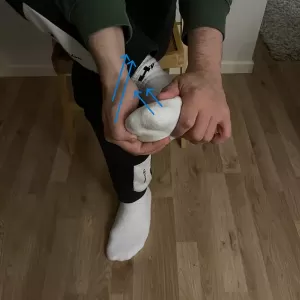How to Cure Plantar Fasciitis in One Week
In this article, I will show you how to cure plantar fasciitis in one week.
I’ll show you the best strategy to deal with plantar fasciitis on a daily basis for 7 days, so you can drive the heel pain away.
Before reading this article, keep in mind that this article isn’t the substitute for medical attention.
Consult your doctor if you have heel pain.
What You Should Know About Plantar Fasciitis
Plantar fasciitis is a common foot condition causing heel pain and stiffness, mainly affecting individuals between 40 and 60 years old.
This condition arises from overuse and strain on the foot, often linked to tight calf muscles and unsuitable footwear.
Obesity, inactive lifestyles, and foot arch issues also increase the risk.
The primary symptom is sharp heel pain, especially noticeable in the morning or after periods of rest.
It’s important to consult a podiatrist for a proper diagnosis and to address related issues like tight muscles or incorrect footwear. Early identification and treatment can prevent long-term complications.
How to Deal With Plantar Fasciitis in One Week
Before getting out of bed, perform this passive stretch for plantar fascia.
Static Plantar Fascia Stretch
Sit comfortably on a chair with your feet flat on the ground.
- Lift one foot and place it over the opposite knee.
- Using your hand, gently pull the toes back towards the shin. This action stretches the plantar fascia on the bottom of the foot.
- Keep your heel firmly planted against the inner thigh of the opposite leg to ensure a proper stretch.
- Hold this position for 30 seconds.
After you’re done with this exercise, take comfortable shoes on as you get out of bed. They will support your plantar fascia throughout the day.
During the day, perform the following stretches and massage techniques:
Wall Stretch for Calf Muscles
Stand facing a wall with your hands placed on the wall at shoulder height.
- Soleus Stretch:
- Step one foot back, keeping the knee slightly bent.
- Bend your front knee and lean forward towards the wall, keeping your back heel on the ground.
- Hold for 30 seconds and feel the stretch in the lower part of your calf.
- Gastrocnemius Stretch:
- This time, extend the back leg fully, keeping the knee straight.
- Bend the front knee and lean towards the wall, ensuring the back heel remains on the ground.
- Hold for 30 seconds to stretch the upper part of the calf.
Incline Plantar Fascia Stretch with Ankle Dorsiflexion
Find a slanted surface or use a wedge or a thick book.
- Stand on the inclined surface with your toes on the higher end and heels on the lower end.
- Shift your weight forward to increase the dorsiflexion of the ankles. This movement stretches the plantar fascia.
- Ensure your knees are straight to engage the stretch fully.
- Hold the stretch for 30 seconds.
You can perform these exercises every waking hour during your day, but it’s also okay if you do these exercises a few times per day.
Let’s move on to how to massage plantar fascia.
Self-Massage Techniques for Plantar Fasciitis
Using Thumbs 1-2min
Sit comfortably and cross one leg over the other to access your foot.
Using your thumbs, apply firm but comfortable pressure and slide them along the arch from the heel to the ball of your foot. Focus on tight or tender areas, employing small circular motions to release tension. Ensure to massage the heel and ball of the foot, areas that bear significant pressure.
Calf Muscle Trigger Point Massage
You would need a foam roller or a massage ball.
- Sit on the floor with your legs extended in front of you.
- Place the foam roller or massage ball under one of your calves.
- Gently roll your calf over the roller or ball, pausing at spots that feel especially tight or tender.
- Apply pressure as needed by pressing down with your hands or adjusting your body weight.
- Roll each calf for 2-3 minutes.
Ice Massage for Plantar Fascia
- While seated, place the frozen water bottle or ice cup under the arch of your foot.
- Roll your foot over it, applying gentle pressure, for about 2-4 minutes.
- Ensure that you cover the entire arch area, from the heel to the ball of the foot.
- This technique not only massages the area but also provides the benefits of cold therapy, reducing inflammation and pain.
And that’s it. Use these methods to ease the pain from plantar fasciitis in one week.
Keep in mind to avoid activities that can cause heel pain as walking a lot, running, jumping and similar.
Here is a full exercise program for dealing with plantar fasciitis. I recommend this guide for learning the long term strategies for dealing with heel pain.

